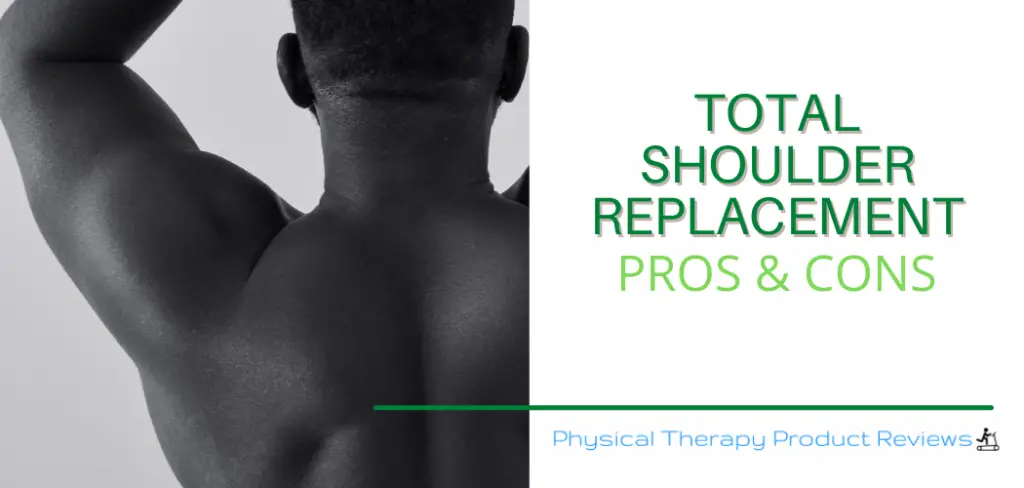
A total shoulder replacement surgery can be intimidating. However, if you’ve been suffering from significant pain, discomfort, and difficulty with your shoulder, it may be to your great benefit to consider the procedure.
It may feel daunting to consider such an encompassing surgery. But…imagine a day without shoulder pain – being able to reach up to the top shelf, lift your grandchild, or sleep comfortably! If you’re considering total shoulder replacement surgery, use this guide to further inform your decision.
The Surgery
The total shoulder replacement procedure is one of the most successful shoulder surgeries out there! Most patients report being completely pain-free after full rehabilitation. After living with your pain and discomfort for so long, that has to sound pretty good!

The surgery is typically recommended to patients with significant osteoarthritis, rotator cuff tears, or other complex injuries. Over 70,000 people undergo a total shoulder replacement each year.
Your surgery will last a few hours and you can expect to spend a couple of days recovering in the hospital. After you are discharged, you’ll begin attending outpatient physical therapy regularly to continue your rehabilitation.
Expected Recovery
 Your physical therapist will lead you through a dedicated rehabilitation program for about 6 months. The initial stages will include a gentle range of motion and you will gradually progress to strengthening and functional tasks.
Your physical therapist will lead you through a dedicated rehabilitation program for about 6 months. The initial stages will include a gentle range of motion and you will gradually progress to strengthening and functional tasks.
You must follow through on your complete rehabilitation to achieve full recovery!
Phase 1 (0-6 weeks): Protect the Shoulder
- Wearing a brace as prescribed by the surgeon
- Gentle range of motion, guided by a physical therapist
- Exercises to encourage blood flow
Phase 2 (6 -12 weeks): Strength Training
- Gradual strengthening
- Continued range of motion work
Phase 3 (12 weeks - 6 months): Functional Return
- Progressive strengthening
- Recreation training
>6 months: You will likely be pain-free!
It can take up to one year before you feel like your strength and range of motion are back to normal. You will be encouraged to continue your exercises at home and may have a few follow-ups with your physical therapist to check your progress.
Initial Stages After a Total Shoulder Replacement
Pros and Cons of a Total Shoulder Replacement
Now that you know a bit more about the basic recovery from a total shoulder replacement, let’s discuss the pros and cons.
Pros of a Shoulder Replacement
There are more upsides to downsides! If you’ve been living a life hindered by a poor range of motion and fitful sleeping because of your shoulder pain, a shoulder replacement can bring great relief.
- Decreased pain: typically a 90% decrease in pain by 6 weeks post-op before pain-free 1-year post-op.
- Improved function of the shoulder: you won’t think twice about reaching up to high shelves or for your seatbelt.
- Improved sleep: no more rude awakenings when you roll over on the affected side.
- Improved range of motion
Cons of a Shoulder Replacement
Just like anything in life, there are a few negatives to undergoing shoulder surgery. Keep in mind that these are typically temporary side effects that will improve with time.
- Wearing a brace for 6 weeks: you will be temporarily limited on moving your shoulder or using the arm.
- Initial surgical limitations and discomfort. Your shoulder will be sore after surgery. Beginning your range of motion exercises and using pain control modalities will be helpful.
- Secondary effects of surgery: you may feel some numbness in your arm, but it should not persist.
- Full recovery can take about 1 year
Tips for Recovery
Once you decide to proceed with your shoulder surgery, make sure you get the most out of it!
- Heed the advice of your surgeon and physical therapist.
- Be strict about the limitations you’ll have after surgery.
- Don’t drive until you’re cleared to do so (it could be over 4 weeks before you’re allowed to drive, so plan accordingly)
- Don’t lift anything you shouldn’t!
- If you have kids in your household, make sure they know to be careful around your shoulder!
- Continue your exercises as advised.
Alternatives to a Shoulder Replacement
 You can discuss other conservative options with your surgeon. These may include injections, physical therapy, or other pain modalities. Such treatments will not fix the problem, but they could provide some relief.
You can discuss other conservative options with your surgeon. These may include injections, physical therapy, or other pain modalities. Such treatments will not fix the problem, but they could provide some relief.
It may be beneficial to attempt a trial of physical therapy prior to your shoulder surgery. Depending on the degree of your injury, you may not achieve full restoration of range of motion and are likely to continue to feel pain.
Conclusion
Total shoulder replacement surgery is a very common and successful procedure. Most patients report being pain free and return to normal levels of range of motion and strength at about 1 year post op. Have a conversation with your surgeon about what you can expect in order to best understand your options moving forward!
Works Referenced:
Grubhofer F, Martinez ARM, Ernstbrunner L, Haberli J, Selig ME, Yi K, Warner JJP. Speed of recovery of the most commonly performed shoulder surgeries. Journal of Shoulder and Elbow Surgery. 2021; 5(4):776-781. https://www.sciencedirect.com/science/article/pii/S2666638321001018
Wiater JM. Shoulder Replacement. American Academy of Orthopaedic Surgeons. https://orthoinfo.aaos.org/en/treatment/shoulder-joint-replacement/
Wilcox RB, Arslanian LE, Millett PJ. Rehabilitation following total shoulder arthroplasty. Journal of Orthopaedic and Sports Physical Therapy. 2005. https://www.jospt.org/doi/pdf/10.2519/jospt.2005.35.12.821
GLP Weight Loss and Back Health: Effective Strategies and Insights
How to Stay Active After Cervical Fractures: Expert Tips and Advice
Dealing with Painful Stairs After Ankle Replacement Surgery
Walking After a Total Ankle Replacement: Tips for a Successful Recovery
Exercises While Non-Weight Bearing After Ankle Replacement: Elevation, AROM, Leg Raises, and More
Ankle Pain with Stairs: Causes and Home Treatment Options
Disclaimer: The information provided in this post is for educational purposes only. This is not a substitute for a medical appointment. Please refer to your physician before starting any exercise program.






